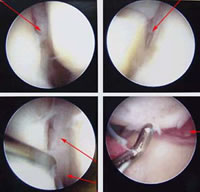Conditions Treated
Arthroscopy of the Wrist
What is it?
Arthroscopy, or "keyhole" surgery as it is commonly known, is a minimally invasive technique that allows a very accurate and detailed assessment of your wrist joint.
Why is it carried out?
Wrist arthroscopy is performed in patients who have had an injury or damage to the wrist joint surface or the soft tissue structures within the wrist. It allows closer inspection of the structures allowing Andy to gauge the degree of damage and plan further treatment and as such, it is a largely diagnostic procedure.
Some treatments can be carried out during keyhole surgery to the wrist such as removing excess scar tissue of damaged cartilage.
Do I need any further investigations?
YES. All patients require x-rays and most have MRI or CT scans prior to wrist arthroscopy.
What does the procedure involve?
Wrist arthroscopy is carried out under general anaesthetic as a day case procedure. 4 small cuts about 5mm long are made on the back of the wrist to allow access to the many joints with a tiny camera and other instruments. The joint is then dilated with water to improve the view.
How long will it take to recover?
After the operation, the wounds are closed with small sutures and dressings and a bandage are applied. You will be given a sling to keep your wrist elevated and help reduce swelling.
You will be reviewed at 2 days by your hand therapist who will take down the bandage and get your wrist moving.
The sutures are removed at 10-12 days.
What are the potential complications?
Any surgical procedure carries risks, however every effort is made to minimize these to ensure the best possible outcome from your surgery.
- Infection - Uncommon and usually treated very successfully with antibiotics
- Delayed healing - Smokers and those with diabetes are more prone to this
- Mal-union - sometimes the position of the fracture may move during treatment. This may lead to the fracture healing in a less than perfect position, although it rarely causes problems unless it is severe
- Painful/Tender Scars - the vast majority of patients complain of some discomfort around the scar and thumb, this is know as pillar pain and generally resolves with time. Rigorous wound care and desensitization as directed by your hand therapist help prevent this.
- Damage to nerves and tendons - this occurs in less than 1% of patients and may require surgical repair.
- Stiffness - Operations to the hand may cause stiffness, this can be minimized by working closely with your hand therapist and getting your hand moving as early as possible.
- CRPS - An uncommon but potentially serious complication of hand surgery leading to pain, swelling and discomfort. It is impossible to predict this problem but working closely with you hand therapist and getting your hand moving early has been proven to significantly reduce the risk of this.
When can I get back to normal activities?
The wrist MUST be kept clean and dry for 10 days until the sutures are removed. Most people should be able to return to "desk job" type activities within 1 week of the operation.
Any manual work, heavy lifting or sporting activities should be avoided for at least 2-4 weeks.
You may return to driving in around 1-2 weeks. Please inform your insurance company that you have recent hand surgery to ensure that are happy for you to do so.

